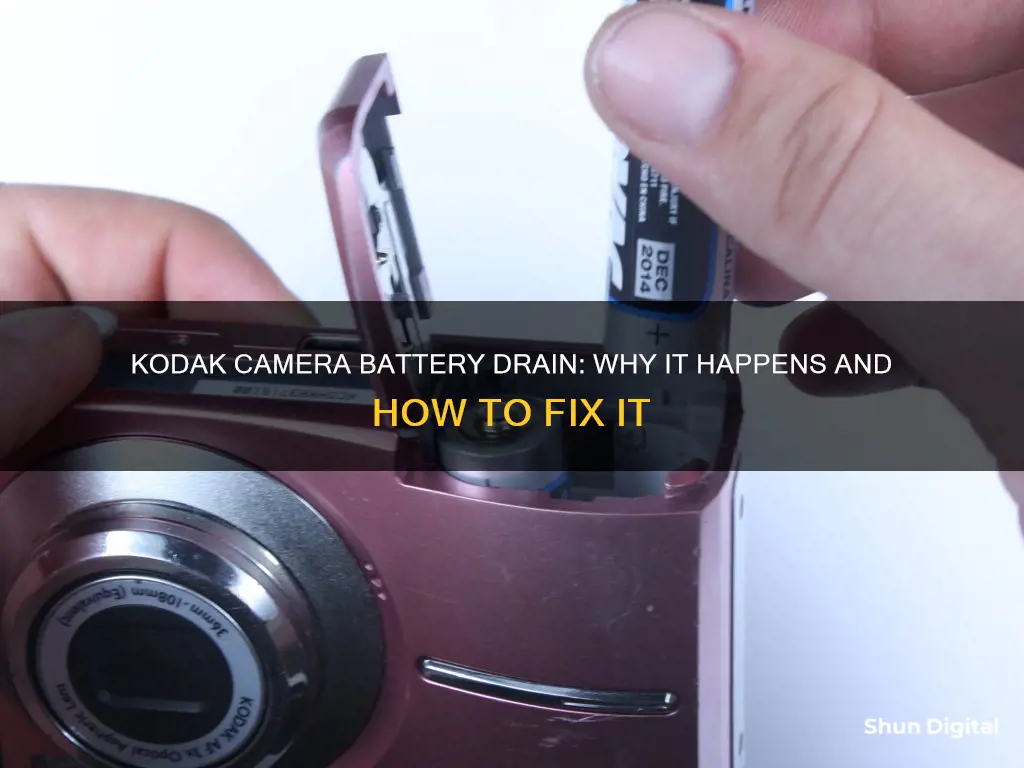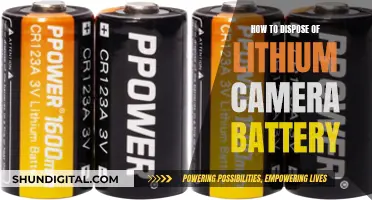
Kodak cameras are a popular choice for photographers of all skill levels, but one common issue that users face is rapid battery drainage. This problem can be caused by several factors, including battery type, camera settings, and improper care. Kodak cameras are known to be demanding on batteries, and certain types, such as alkaline batteries, are not recommended due to their poor performance and potential to leak. To extend battery life, users should limit activities that drain power, such as using Liveview, reviewing pictures on the camera screen, and excessive use of the flash. Additionally, dirt on battery contacts can impact battery life, so it is important to keep them clean.
| Characteristics | Values |
|---|---|
| Camera model | Kodak EasyShare CX6330 zoom digital camera |
| Battery type | Kodak CRV3 lithium battery, Kodak EasyShare Ni-MH rechargeable battery pack, Kodak Max digital camera batteries (AA), 1.2 volt AA nickel metal hydride (Ni-MH) batteries, rechargeable, 1.5 volt AA lithium batteries |
| Battery life | 15-18 shots |
| Battery life improvement methods | Limit using Liveview, reviewing pictures on the camera screen, and using the flash. Wipe the battery contacts with a clean, dry cloth before loading them into the camera. |
| Battery life influencers | Battery age, usage conditions, and type |
| Battery performance | Reduced at temperatures below 41° F (5° C) |
| Battery safety | Do not allow batteries to touch metal objects, including coins, to prevent short-circuiting, discharging energy, overheating, or leaking. |
| Expected battery life | 2 Kodak Max digital camera batteries (AA) - 180 pictures (per charge) |
What You'll Learn

Kodak recommends against using alkaline batteries
Kodak cameras are a popular choice for both beginner and professional photographers. However, some users have reported issues with their Kodak camera batteries dying quickly or not holding a charge. If you're experiencing this problem, there are several potential causes and solutions you can explore.
Firstly, Kodak does not recommend or support the use of alkaline batteries in their cameras. This is because digital cameras have high power demands, and alkaline batteries may not perform well under these challenging conditions. Alkaline batteries are intended for long-term use in low-drain devices such as game console remotes and are not ideal for high-drain devices like cameras. Using alkaline batteries in a Kodak camera can lead to frequent battery changes and even camera malfunction. Therefore, it is advisable to opt for alternative battery types, such as lithium or rechargeable batteries, to ensure optimal performance and longer battery life.
To improve battery life in your Kodak camera, there are several measures you can take. Firstly, limit activities such as using the camera screen as a viewfinder, reviewing pictures on the camera screen, and excessive use of the flash. These activities consume significant power and can drain your battery quickly. Additionally, remember to keep your battery contacts clean by wiping them with a dry cloth before inserting the batteries. This will help ensure a good connection and improve battery performance.
Furthermore, battery life is significantly influenced by factors such as age, usage conditions, and temperature. Older batteries tend to lose their ability to hold a charge over time, so it is recommended to replace them periodically. Similarly, cold temperatures can reduce battery performance, so it is advisable to carry spare batteries and keep them warm when using your camera in cold weather. Additionally, avoid exposing your batteries to extremely high temperatures as this can degrade their quality.
In some cases, a malfunctioning battery may be caused by faulty connections between the battery and the camera. Ensure that all connections are secure and tight by opening the battery compartment and inspecting the contacts. If you identify any loose connections, tighten them, and if the issue persists, consider replacing the battery.
In conclusion, while there are several factors that can contribute to battery drain in your Kodak camera, following the recommendations provided by Kodak and optimizing your camera settings and battery care practices can help you achieve better battery life and ensure your camera is always ready to capture the perfect shot.
Revitalizing Lithium-Ion Camera Batteries: Pro Tips for Photographers
You may want to see also

Digital cameras drain batteries quickly
Digital cameras are notorious for draining batteries quickly, and there are several reasons why this happens. Firstly, digital cameras require a lot of power to run efficiently. The two main components that use the most battery power are the monitor (LCD) and the flash. By minimising the use of the LCD by using a viewfinder, if available, and reducing the amount of flash shots, you can help extend your camera's battery life.
Another reason digital cameras drain batteries quickly is that they use alkaline batteries, which are not ideal for this type of device. Alkaline batteries are designed for low-drain devices such as radios or alarm clocks and will fail quickly in high-drain devices like digital cameras. Lithium batteries are a better option for digital cameras as they are designed for electronics and will last much longer.
Additionally, rechargeable batteries, which are commonly used in digital cameras, can lose their ability to hold a full charge over time. If your rechargeable batteries are a few years old, you may need to replace them. It's also important to ensure that you are using the correct type of batteries for your camera, as using the wrong type can also lead to faster drainage.
Other factors that can contribute to battery drainage include leaving the camera on, using certain camera settings such as automatic flash, and operating the camera in cold temperatures. To conserve battery life, it's recommended to turn off the camera when not in use, adjust camera settings to reduce power usage, and keep the camera warm by storing it close to your body when in cold conditions.
Finally, it's worth noting that some cameras may have a faulty battery or charger, which can cause the battery to drain quickly. If you suspect this might be the case, it's best to send your camera, along with the battery and charger, to a camera service centre for inspection.
Night Owl Camera Batteries: How Long Do They Last?
You may want to see also

Check camera settings
To improve your Kodak camera's battery life, there are several settings you can check and adjust.
Firstly, if you are using the LCD screen instead of the viewfinder to set up your shots, try to reduce the amount of time you spend using it. You can also disable post-shot reviews and lower the brightness setting. Similarly, if you are using zoom, try to get closer to your subject instead, as the motor that moves the lens uses up a lot of power.
Another setting to check is whether your autofocus is set to continuous. If not needed, you can switch to one-shot or Autofocus Single mode, which will reduce the impact on your battery.
If you are using the shutter button to focus your shot before taking it, each press of the button will cause the lens to reset and refocus, which uses up more power.
If you are shooting during the day, you can also try disabling the automatic flash setting, as well as any other features you don't need, such as beeps and other sound effects.
Finally, check that you are using power-saving mode, and make sure your camera is switched off when not in use.
Choosing the Right Charger for Your Camera: A Guide
You may want to see also

Remove batteries when not in use
To ensure your Kodak camera's batteries last longer, it is recommended to remove them when the camera is not in use. This is because digital cameras use up battery life even when they are not being used. The LCD screen on the back of the camera, for example, uses a lot of battery power. Therefore, it is advisable to use the viewfinder instead of the screen when taking pictures.
Additionally, it is important to note that the type of battery you use can also impact how long they last. Kodak does not recommend using alkaline batteries as they are not suitable for high-drain devices like digital cameras. Instead, Kodak suggests using Nickel Metal Hydride (Ni-MH) rechargeable batteries, as these delivered the best results in Kodak lab tests.
Other ways to preserve your camera's battery life include limiting the use of the flash, avoiding taking videos, and keeping the camera warm in cold weather.
Charging the Argus 2: How Long to Wait?
You may want to see also

Cold temperatures reduce battery performance
Cold temperatures slow down the chemical reactions that occur inside a battery. This means that a battery used at a low temperature produces less current than at a higher temperature. As cold batteries run down, they quickly reach the point where they cannot deliver enough current to keep up with the demand.
Cold temperatures can be particularly harmful to the well-being of a standard lead-acid battery. The more you pull from a lead-acid battery in cold temperatures, the weaker it will become.
Charging batteries in freezing temperatures can also cause issues. The lithium ions inside the battery are soaked up by the porous graphite that makes up the anode, the negative terminal of the battery. However, below freezing, many lithium ions coat the surface of the anode instead, meaning there's less lithium available to cause the flow of electricity, and the battery's capacity drops.
Cold temperatures must be taken into account when using batteries, as they can be harmful to the health and longevity of the unit.
Best Batteries for SpyPoint Camera: Ultimate Guide
You may want to see also
Frequently asked questions
There are many reasons why your Kodak camera may be using up batteries quickly. Firstly, digital cameras are demanding on batteries, and not all batteries perform well under these conditions. Kodak does not recommend or support the use of alkaline batteries, as they are not suitable for high-drain devices like cameras. Instead, try using lithium batteries, as they are intended for electronics and will last longer. Additionally, limit the use of your camera's flash, live view, and picture review on the camera screen, as these can drain battery life.
Make sure to keep your battery clean and dry, as dirt and moisture can affect performance. It is also important to store your batteries properly when not in use. Keep them at room temperature in a dry place, and avoid extreme temperatures. Finally, ensure that your battery connections are secure and tight, as faulty connections can cause your battery to drain more quickly.
This depends on the model of your Kodak camera. Kodak cameras can use Kodak CRV3 lithium batteries, Kodak EasyShare Ni-MH rechargeable battery packs, Kodak Max digital camera batteries (AA), 1.2-volt AA nickel metal hydride (Ni-MH) batteries, and 1.5-volt AA lithium batteries.







